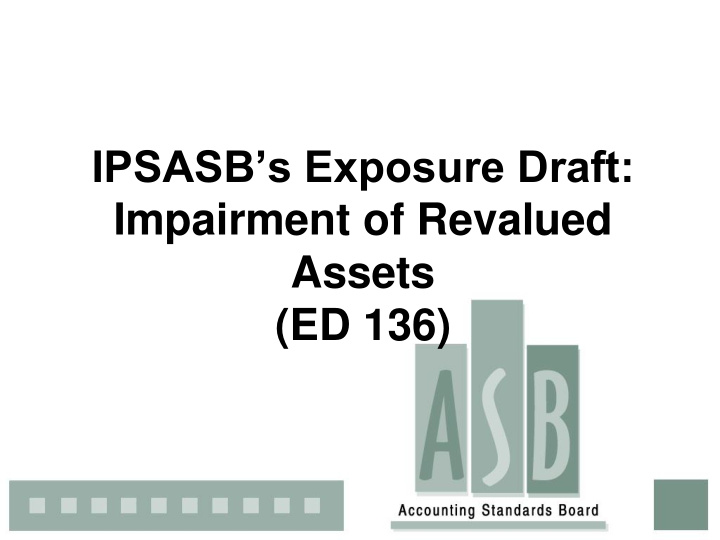



IPSASB’s Exposure Draft: Impairment of Revalued Assets (ED 136)
Disclaimer The views and opinions expressed in this presentation are those of the individual. Official positions of the ASB on accounting matters are determined only after extensive due process and deliberation .
Overview • Background to IPSASB’s project • Due process • Proposed amendments • Impact of IPSASB’s developments locally • Specific matter for comment
Background • Application of impairment tests for revalued assets is not required in IPSAS 21 and 26 • IPSASB’s initial view was that such a requirement would be onerous: – impairments are taken into account in valuation as assets will be revalued with sufficient regularity – difference between CA and FV less C2S = disposal costs → not material
Background • Request from IPSASB’s stakeholders to withdraw scope exclusion • IPSASB reconsidered initial thinking → issued ED 57 to amend IPSAS 21 and IPSAS 26 – revalued assets to be within scope of IPSAS 21 and IPSAS 26
Due Process • IPSASB issued ED 57 for comment in October 2015 • Board’s process is to issue concurrent ED locally • Consultations with local stakeholders – comments used to formulate response to IPSASB • Deadline for comment – Board: 31 December 2015 – IPSASB: 15 January 2016
Proposed Amendments • Assets measured under revaluation model (in IPSAS 17 and 31) are within scope of IPSAS 21 and 26 • Assess at each reporting date if there’s an indication of impairment
Proposed Amendments • Treatment of i/loss [par 54A] – recognise in revaluation surplus to extent i/loss does not exceed the amount in revaluation surplus for that class of revalued assets • Treatment of reversal of i/loss [par 69A] – recognise in revaluation reserve to increase revaluation surplus for that class of revalued assets; – BUT recognise in surplus/deficit to extent of i/loss previously recognised in surplus/deficit on same class of revalued asset
Transitional Provisions • Apply amendments prospectively
Consequential Amendments IPSAS 17 • Clarified that if revalued asset is impaired → does not mean entire class of asset should be revalued as required by IPSAS 17 IPSAS 31 • Impairment test applies to all assets not only those measured under cost model
Impact of developments locally • Board did not support IPSASB’s view when developing GRAP 21 and 26 • Board disregarded scope exclusion – not too onerous to test impairment on revalued assets – entities would not revalue with sufficient regularity due to cost revaluing certain assets • Standards include impairment of revalued assets and guidance on i/losses related to such assets
Impact of developments locally • Board limits recognition of i/losses and reversals against the revaluation surplus or surplus/deficit for the same revalued asset NOT for class of revalued assets • No changes will be made to Standards of GRAP
Specific matter for comment
Do you agree with the changes to IPSAS 21 and IPSAS 26, and consequential amendments to IPSAS 17 and IPSAS 31?
THANK YOU
Contact details Tel: (011) 697-0660 Fax: (011) 697-0666 Email: info@asb.co.za Website: www.asb.co.za : Accounting Standards Board : @ASB_SA
Recommend
More recommend